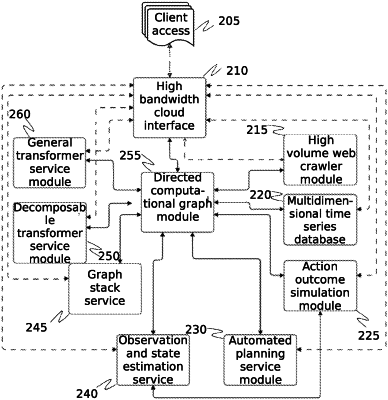| CPC H04L 63/20 (2013.01) [G06F 16/2477 (2019.01); G06F 16/951 (2019.01); H04L 63/1425 (2013.01); H04L 63/1433 (2013.01); H04L 63/1441 (2013.01)] | 4 Claims |

|
1. A system for self-adjusting cybersecurity analysis and rating based on heterogeneous data and reconnaissance, comprising:
a computing device comprising a memory, a processor, and a network interface;
an automated planning service module, comprising a second plurality of programming instructions stored in the memory of, and operating on the processor of, the computing device, wherein the second plurality of programming instructions, when operating on the processor, cause the computing device to periodically or continuously establish a cybersecurity score by:
defining a target network by identifying internet protocol addresses and subdomains of the target network, verifying domain name system information for each internet protocol address and subdomain of the target network, and assigning an Internet reconnaissance score;
collecting domain name system leak information by identifying improper network configurations in the internet protocol addresses and subdomains of the target network, and assigning a domain name system leak information score;
analyzing web applications used by the target network to identify vulnerabilities in the web applications that could allow unauthorized access to the target network, and assigning a web application security score;
searching social media networks for information of concern related to personnel identified within the target network, and assigning a social network score;
conducting a scan of the target network for open TCP/UDP ports, and assigning an open port score;
identifying leaked credentials associated with the target network that are found to be disclosed in previous breach incidents, and assigning a credential score;
gathering version and update information for hardware and software systems within the boundary of the target network, checking version and update information for the hardware and software systems within the boundary of the target network, and assigning a patching frequency score; and
identifying content of interest contained within the target network, performing an Internet search to identify references to the content of interest, and assigning an open-source intelligence score; and
a cybersecurity scoring engine comprising a third plurality of programming instructions stored in the memory of, and operating on the processor of, the computing device, wherein the third plurality of programming instructions, when operating on the processor, cause the computing device to create a weighted cybersecurity score by:
assigning a weight to each of the Internet reconnaissance score, the domain name system leak information score, the web application security score, the social network score, the open port score, the credential score, the patching frequency score, and the open-source intelligence score;
combining the weighted scores into the weighted cybersecurity score; and
a feedback engine comprising a fourth plurality of programming instructions stored in the memory of, and operating on the processor of, the computing device, wherein the fourth plurality of programming instructions, when operating on the processor, cause the computing device to:
compare the weighted cybersecurity score to a score set point;
recommend changes to network security for the target network to either increase or decrease network security to bring the score into equilibrium with the score set point.
|